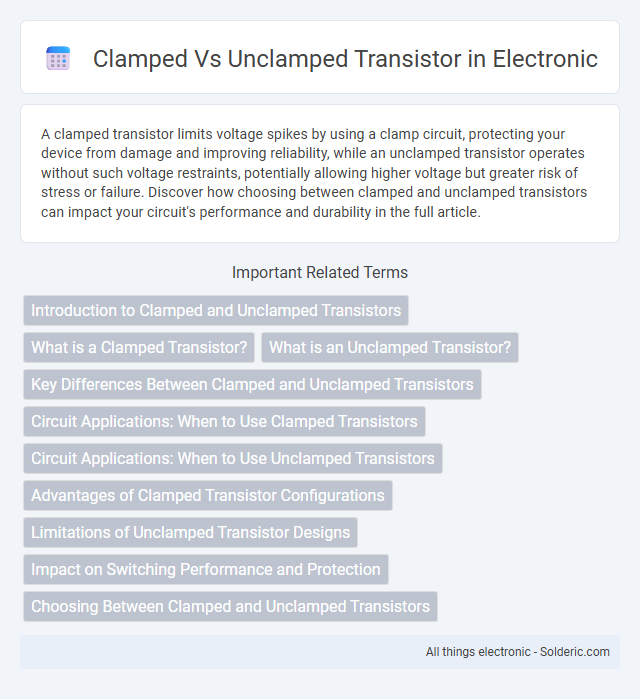A clamped transistor limits voltage spikes by using a clamp circuit, protecting your device from damage and improving reliability, while an unclamped transistor operates without such voltage restraints, potentially allowing higher voltage but greater risk of stress or failure. Discover how choosing between clamped and unclamped transistors can impact your circuit's performance and durability in the full article.
Comparison Table
| Feature | Clamped Transistor | Unclamped Transistor |
|---|---|---|
| Voltage Control | Voltage is limited by clamping circuit | Voltage can vary freely without limitation |
| Protection | Provides overvoltage protection | No built-in overvoltage protection |
| Switching Speed | May have slower switching due to clamp delay | Faster switching, no clamp delay |
| Power Dissipation | Higher, due to clamping energy absorption | Lower, no clamping losses |
| Application | Used in circuits requiring voltage limitation and protection | Used where maximum voltage and speed are critical |
| Reliability | Enhanced, due to protection against transients | Lower, susceptible to voltage spikes |
Introduction to Clamped and Unclamped Transistors
Clamped transistors incorporate protective elements such as diodes or resistors to limit voltage spikes and prevent device damage during switching operations, enhancing circuit stability and reliability. Unclamped transistors operate without these protective components, allowing higher voltage swings but increasing risks of voltage overshoot and potential device failure. Understanding the behavior and applications of clamped versus unclamped transistors is essential for designing efficient power electronics and switching circuits.
What is a Clamped Transistor?
A clamped transistor is designed to restrict voltage fluctuations by incorporating protective components that prevent the voltage from exceeding a specified limit, thereby safeguarding the transistor from damage due to overvoltage conditions. This clamping action ensures stable operation and enhances the reliability of circuits, especially in switching and amplification applications. Understanding how clamped transistors work can help you optimize your electronic designs for improved performance and durability.
What is an Unclamped Transistor?
An unclamped transistor operates without any external circuit elements to limit its voltage or current during switching, resulting in potentially higher voltage stress and increased risk of damage. This lack of clamping means the transistor relies solely on its internal structure and device physics to withstand voltage spikes, often seen in power electronics applications like inductive load switching. Designers must consider robust transistor specifications or protective circuits to mitigate failures caused by unclamped operation.
Key Differences Between Clamped and Unclamped Transistors
Clamped transistors incorporate built-in circuits to limit voltage spikes, enhancing device reliability by preventing excessive voltage stress. Unclamped transistors lack such voltage-limiting features, making them more susceptible to voltage transients and potential damage under high-stress conditions. The primary difference lies in overvoltage protection, where clamped transistors provide controlled switching behavior, and unclamped transistors offer faster but riskier operation without voltage suppression.
Circuit Applications: When to Use Clamped Transistors
Clamped transistors are ideal in power amplifier circuits and switching regulators where voltage spikes must be limited to prevent damage and ensure stable operation. They are commonly used in motor control circuits and inductive load drivers to suppress voltage overshoot caused by inductive kickback. Employing clamped transistors in these applications enhances reliability by maintaining voltage within safe limits during switching transitions.
Circuit Applications: When to Use Unclamped Transistors
Unclamped transistors are ideal in applications requiring high-speed switching where minimizing energy loss and switching delay is critical, such as in power inverters and switched-mode power supplies. They allow the transistor to operate without the voltage being limited by a clamp diode, enabling faster transitions and improved efficiency under dynamic loads. Your circuits benefit from unclamped transistors when precise control over switching behavior and reduced switching losses are essential for performance optimization.
Advantages of Clamped Transistor Configurations
Clamped transistor configurations enhance circuit stability by preventing voltage overshoot and protecting the transistor from breakdown caused by excessive voltage stress. These configurations improve switching performance and reduce power dissipation, leading to higher efficiency and longer device lifespan. Clamping also enables better control of transient responses in power electronics and RF amplifiers, minimizing noise and distortion.
Limitations of Unclamped Transistor Designs
Unclamped transistor designs lack built-in protection against voltage spikes, making them vulnerable to high-voltage transients that can cause device failure. These limitations result in reduced reliability and increased risk of damage during inductive load switching or fault conditions. Your circuits may suffer from decreased lifespan and performance instability without proper clamping mechanisms.
Impact on Switching Performance and Protection
Clamped transistors feature built-in protection mechanisms that limit voltage overshoot during switching, enhancing device reliability and reducing electromagnetic interference. Unclamped transistors allow higher voltage spikes, which can improve switching speed but increase the risk of device damage and signal integrity issues. Your choice between clamped and unclamped transistors directly affects switching performance trade-offs and the need for external protection circuits.
Choosing Between Clamped and Unclamped Transistors
Choosing between clamped and unclamped transistors depends on the application requirements such as switching speed, voltage stress, and thermal performance. Clamped transistors incorporate internal diodes or clamps to limit voltage spikes, making them ideal for inductive load switching and enhancing device protection. Unclamped transistors lack these protective features, offering faster switching but requiring external circuitry to prevent voltage overshoot and ensure reliability.
Clamped vs Unclamped transistor Infographic

 solderic.com
solderic.com